论文:DreamBooth: Fine Tuning Text-to-Image Diffusion Models for Subject-Driven Generation
项目:DreamBooth: Fine Tuning Text-to-Image Diffusion Models for Subject-Driven Generation
代码:Dreambooth-Stable-Diffusion
1. 任务简介
当前的文生图模型已经可以根据给定的prompt生成高质量的图片。然后这些模型并不能模仿给定参考图片中物体的样子在不同情景中来生成新颖的图片(即参考图片中的物体的样子基本不变,而改变其背景等)。DreamBooth是一种个性化文生图模型:给定某个物体的几张图片作为输入,通过微调预训练的文生图模型(如Imagen),将一个独特的标识符和该物体进行绑定,这样就可以通过含有该标识符的prompt在不同场景下生成包含该物体的新颖图片。如下图所示,输入图片中包含一个闹钟,我们希望在不同场景下生成的图片里闹钟的样子尽可能与输入图片保持一致

2. 方法
作者希望将输入图片中的物体与一个特殊标识符绑定在一起,即用这个特殊标记符来表示输入图片中的物体。因此作者为微调模型设计了一种prompt格式:a [identifier] [class noun],即将所有输入图片的promt都设置成这种形式,其中identifier是一个与输入图片中物体相关联的特殊标记符,class noun是对物体的类别描述。这里之所以在prompt中加入类别,是因为作者想利用预训练模型中关于该类别物品的先验知识,并将先验知识与特殊标记符相关信息进行融合,这样就可以在不同场景下生成不同姿势的目标物体
作者提出的方法,大致如下图所示,即仅仅通过3到5张图片去微调文生图模型,使得模型能将输入图片中特定的物品和prompt中的特殊标记符关联起来
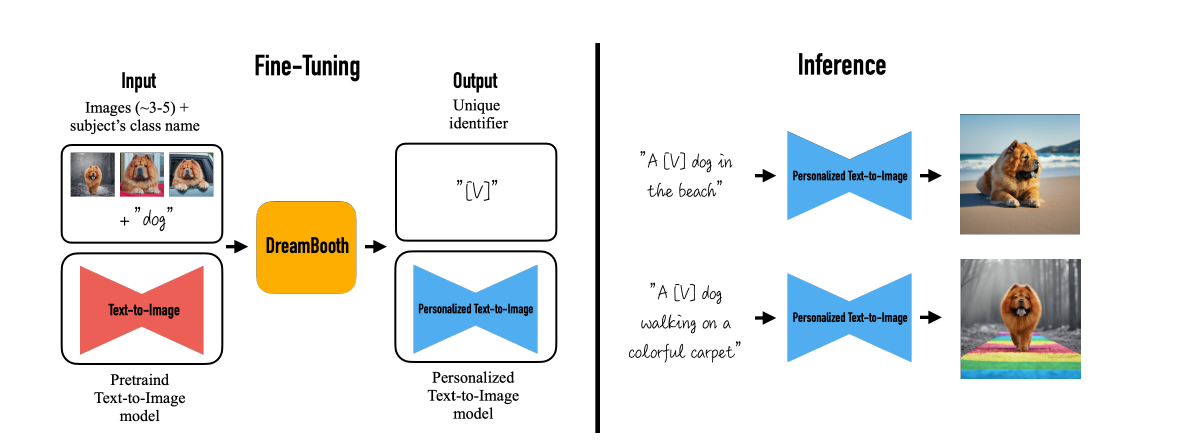
训练的具体流程图如下:
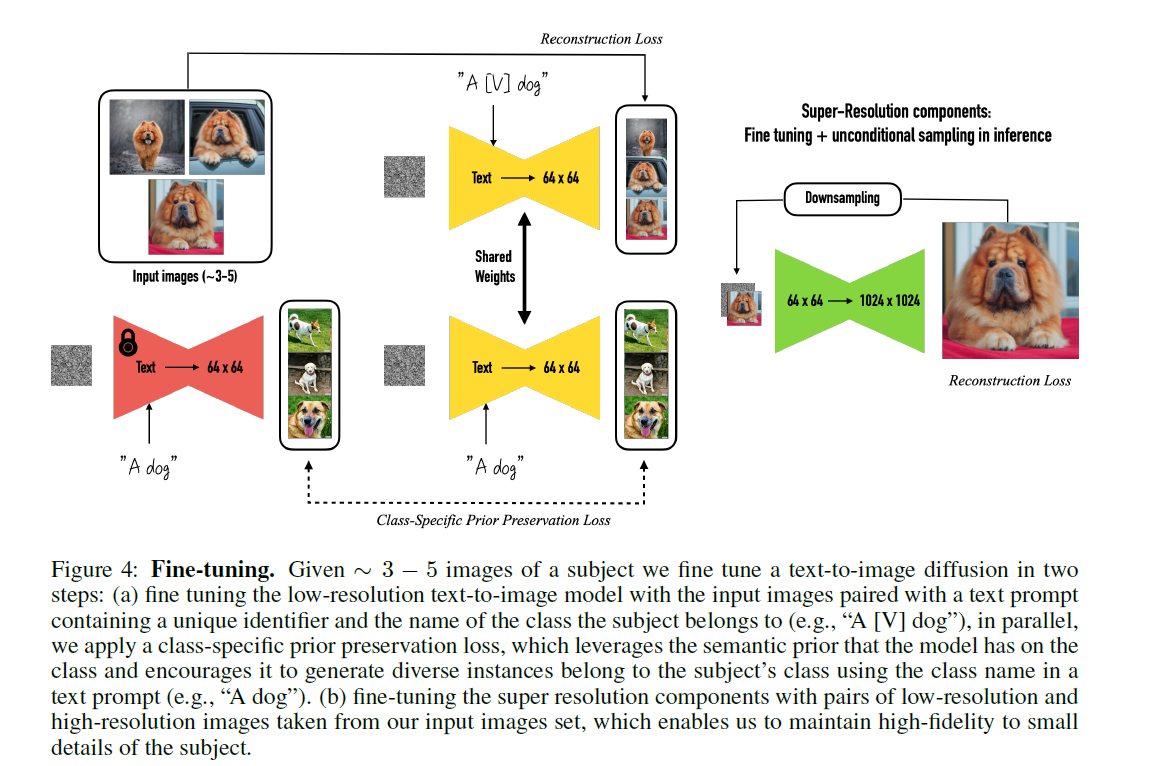
2.1 特殊标记符的选择
用什么单词来代替这个特殊标记符呢?
(1)最简单的方法就是随机选择一个已经存在的单词,通过这种方式构建特殊标记符会造成一些问题,随着训练的进行,模型会忘记这个单词的本来含义,并将输入图片中的物品的含义与该单词绑定。
(2)用英文字母构造一个特殊标记符,如xxy5syt00,当分词器可能会将这个词分开,变成多个子词,而扩散模型对这些子词有非常丰富的先验。
(3)最后作者通过在词表中选择罕见词来作为特殊标记符,这样避免了预训练模型对特殊标记符有很强烈的先验知识。
2.2 损失函数
论文提出的方法是想用少量图片(如3到5张)去微调文生图模型,微调过程中这些图片中都包含有相同的物体,且图片对应的prompt基本相同,都为a[identifier] [class noun]的形式,如果只用普通的微调方式,会出现两个问题:
(1)过拟合
(2)语言漂移:在大量文本语料上预训练的语言模型,在特定任务上微调时,它会逐渐忘记通用的语言知识,而仅仅适配特定的任务
考虑到上面两个问题,作者提出使用预训练文生图模型自己生成的图片来监督微调过程的方法,即用预训练的diffusion模型,输入随机初始化的噪声 Z t 1 ∼ N ( 0 , I ) Z_{t1} \sim N(0, I) Zt1∼N(0,I) 和条件 c p r c_{pr} cpr 来生成一部分图片数据 x p r x_{pr} xpr,注意, c p r c_{pr} cpr对应的prompt形式为a [class noun],也就是输入的类别。比如我们微调的prompt设置为一只可爱的金毛狗,那么此处生成数据输入的prompt为一只可爱的狗,把这些生成的狗的图片和之前准备金毛的图片合在一起训练,防止微调过程后模型只会生成金毛,而忘了其他狗。因此作者使用了如下损失函数
E x , c , ϵ , ϵ ′ , t [ w t ∥ x ^ θ ( α t x + σ t ϵ , c ) − x ∥ 2 2 + λ w t ′ ∥ x ^ θ ( α t ′ x p r + σ t ′ ϵ ′ , c p r ) − x p r ∥ 2 2 ] , \mathbb{E}_{\mathbf{x}, \mathbf{c}, \boldsymbol{\epsilon}, \boldsymbol{\epsilon}^{\prime}, t}\left[w_t\left\|\hat{\mathbf{x}}_\theta\left(\alpha_t \mathbf{x}+\sigma_t \boldsymbol{\epsilon}, \mathbf{c}\right)-\mathbf{x}\right\|_2^2+\lambda w_{t^{\prime}}\left\|\hat{\mathbf{x}}_\theta\left(\alpha_{t^{\prime}} \mathbf{x}_{\mathrm{pr}}+\sigma_{t^{\prime}} \epsilon^{\prime}, \mathbf{c}_{\mathrm{pr}}\right)-\mathbf{x}_{\mathrm{pr}}\right\|_2^2\right], Ex,c,ϵ,ϵ′,t[wt∥x^θ(αtx+σtϵ,c)−x∥22+λwt′∥x^θ(αt′xpr+σt′ϵ′,cpr)−xpr∥22],
前半部分让模型学习特定物品的表示,后半通过生成图片的监督防止模型忘记先验知识,其中 X ^ θ \hat X_{\theta} X^θ代表扩散模型,即输入图片 x x x,通过扩散模型加噪去噪后生成的图片尽量要和原始输入图片 x x x尽量保持一致,后半部分对模型生成的训练数据也一样。
最后我们看下微调后模型生成图片的结果
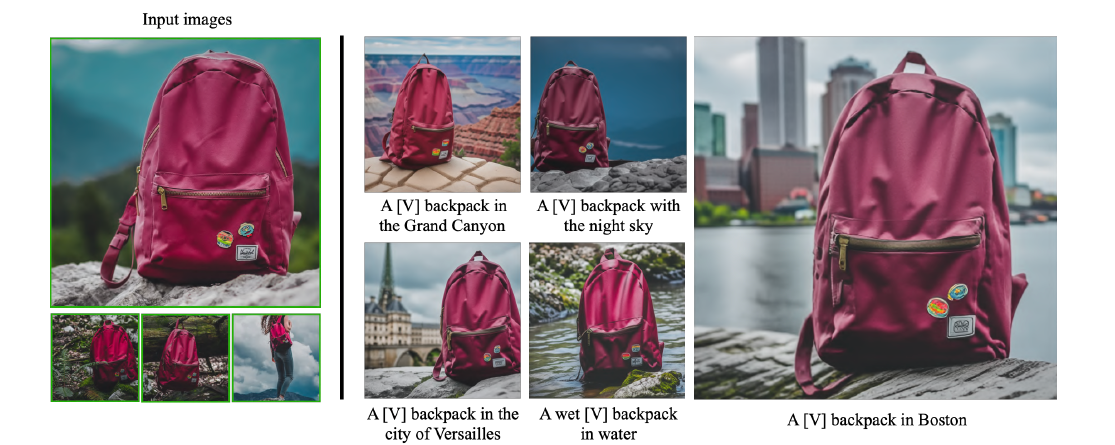
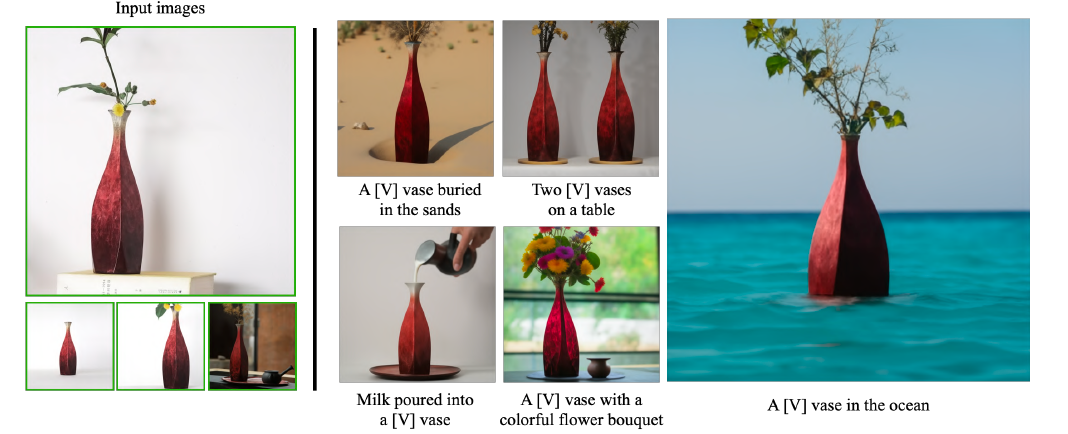
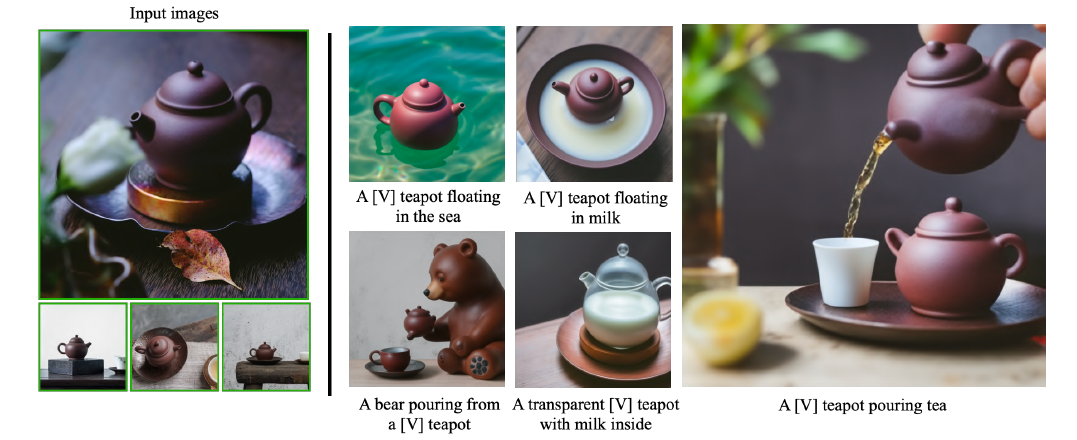
可以看到生成图片中的物品能够保留输入图片中物品的关键信息
3. 小结
整篇论文相对来说比较简单,但是在实际应用中确实很实用,毕竟在很多场景我们都希望某些物品是保持不变的。本篇论文最重要的地方在于损失函数的设计,通过加入模型自己生成图片一起训练来防止模型忘记先验知识
4. 训练
可以直接通过diffusers python库来快速通过dreambooth微调stable diffusion,复制代码train_dreambooth得到如下代码
#!/usr/bin/env python
# coding=utf-8
# Copyright 2023 The HuggingFace Inc. team. All rights reserved.
#
# Licensed under the Apache License, Version 2.0 (the "License");
# you may not use this file except in compliance with the License.
# You may obtain a copy of the License at
#
# http://www.apache.org/licenses/LICENSE-2.0
#
# Unless required by applicable law or agreed to in writing, software
# distributed under the License is distributed on an "AS IS" BASIS,
# WITHOUT WARRANTIES OR CONDITIONS OF ANY KIND, either express or implied.
# See the License for the specific language governing permissions andimport argparse
import gc
import hashlib
import itertools
import logging
import math
import os
import shutil
import warnings
from pathlib import Pathimport numpy as np
import torch
import torch.nn.functional as F
import torch.utils.checkpoint
import transformers
from accelerate import Accelerator
from accelerate.logging import get_logger
from accelerate.utils import ProjectConfiguration, set_seed
from huggingface_hub import create_repo, model_info, upload_folder
from packaging import version
from PIL import Image
from PIL.ImageOps import exif_transpose
from torch.utils.data import Dataset
from torchvision import transforms
from tqdm.auto import tqdm
from transformers import AutoTokenizer, PretrainedConfigimport diffusers
from diffusers import (AutoencoderKL,DDPMScheduler,DiffusionPipeline,DPMSolverMultistepScheduler,StableDiffusionPipeline,UNet2DConditionModel,
)
from diffusers.optimization import get_scheduler
from diffusers.utils import check_min_version, is_wandb_available
from diffusers.utils.import_utils import is_xformers_availableif is_wandb_available():import wandb# Will error if the minimal version of diffusers is not installed. Remove at your own risks.
check_min_version("0.20.0.dev0")logger = get_logger(__name__)def save_model_card(repo_id: str,images=None,base_model=str,train_text_encoder=False,prompt=str,repo_folder=None,pipeline: DiffusionPipeline = None,
):img_str = ""for i, image in enumerate(images):image.save(os.path.join(repo_folder, f"image_{i}.png"))img_str += f"\n"yaml = f"""
---
license: creativeml-openrail-m
base_model: {base_model}
instance_prompt: {prompt}
tags:
- {'stable-diffusion' if isinstance(pipeline, StableDiffusionPipeline) else 'if'}
- {'stable-diffusion-diffusers' if isinstance(pipeline, StableDiffusionPipeline) else 'if-diffusers'}
- text-to-image
- diffusers
- dreambooth
inference: true
---"""model_card = f"""
# DreamBooth - {repo_id}This is a dreambooth model derived from {base_model}. The weights were trained on {prompt} using [DreamBooth](https://dreambooth.github.io/).
You can find some example images in the following. \n
{img_str}DreamBooth for the text encoder was enabled: {train_text_encoder}.
"""with open(os.path.join(repo_folder, "README.md"), "w") as f:f.write(yaml + model_card)def log_validation(text_encoder, tokenizer, unet, vae, args, accelerator, weight_dtype, epoch, prompt_embeds, negative_prompt_embeds
):logger.info(f"Running validation... \n Generating {args.num_validation_images} images with prompt:"f" {args.validation_prompt}.")pipeline_args = {}if vae is not None:pipeline_args["vae"] = vaeif text_encoder is not None:text_encoder = accelerator.unwrap_model(text_encoder)# create pipeline (note: unet and vae are loaded again in float32)pipeline = DiffusionPipeline.from_pretrained(args.pretrained_model_name_or_path,tokenizer=tokenizer,text_encoder=text_encoder,unet=accelerator.unwrap_model(unet),revision=args.revision,torch_dtype=weight_dtype,**pipeline_args,)# We train on the simplified learning objective. If we were previously predicting a variance, we need the scheduler to ignore itscheduler_args = {}if "variance_type" in pipeline.scheduler.config:variance_type = pipeline.scheduler.config.variance_typeif variance_type in ["learned", "learned_range"]:variance_type = "fixed_small"scheduler_args["variance_type"] = variance_typepipeline.scheduler = DPMSolverMultistepScheduler.from_config(pipeline.scheduler.config, **scheduler_args)pipeline = pipeline.to(accelerator.device)pipeline.set_progress_bar_config(disable=True)if args.pre_compute_text_embeddings:pipeline_args = {"prompt_embeds": prompt_embeds,"negative_prompt_embeds": negative_prompt_embeds,}else:pipeline_args = {"prompt": args.validation_prompt}# run inferencegenerator = None if args.seed is None else torch.Generator(device=accelerator.device).manual_seed(args.seed)images = []if args.validation_images is None:for _ in range(args.num_validation_images):with torch.autocast("cuda"):image = pipeline(**pipeline_args, num_inference_steps=25, generator=generator).images[0]images.append(image)else:for image in args.validation_images:image = Image.open(image)image = pipeline(**pipeline_args, image=image, generator=generator).images[0]images.append(image)for tracker in accelerator.trackers:if tracker.name == "tensorboard":np_images = np.stack([np.asarray(img) for img in images])tracker.writer.add_images("validation", np_images, epoch, dataformats="NHWC")if tracker.name == "wandb":tracker.log({"validation": [wandb.Image(image, caption=f"{i}: {args.validation_prompt}") for i, image in enumerate(images)]})del pipelinetorch.cuda.empty_cache()return imagesdef import_model_class_from_model_name_or_path(pretrained_model_name_or_path: str, revision: str):text_encoder_config = PretrainedConfig.from_pretrained(pretrained_model_name_or_path,subfolder="text_encoder",revision=revision,)model_class = text_encoder_config.architectures[0]if model_class == "CLIPTextModel":from transformers import CLIPTextModelreturn CLIPTextModelelif model_class == "RobertaSeriesModelWithTransformation":from diffusers.pipelines.alt_diffusion.modeling_roberta_series import RobertaSeriesModelWithTransformationreturn RobertaSeriesModelWithTransformationelif model_class == "T5EncoderModel":from transformers import T5EncoderModelreturn T5EncoderModelelse:raise ValueError(f"{model_class} is not supported.")def parse_args(input_args=None):parser = argparse.ArgumentParser(description="Simple example of a training script.")parser.add_argument("--pretrained_model_name_or_path",type=str,default=None,required=True,help="Path to pretrained model or model identifier from huggingface.co/models.",)parser.add_argument("--revision",type=str,default=None,required=False,help=("Revision of pretrained model identifier from huggingface.co/models. Trainable model components should be"" float32 precision."),)parser.add_argument("--tokenizer_name",type=str,default=None,help="Pretrained tokenizer name or path if not the same as model_name",)parser.add_argument("--instance_data_dir",type=str,default=None,required=True,help="A folder containing the training data of instance images.",)parser.add_argument("--class_data_dir",type=str,default=None,required=False,help="A folder containing the training data of class images.",)parser.add_argument("--instance_prompt",type=str,default=None,required=True,help="The prompt with identifier specifying the instance",)parser.add_argument("--class_prompt",type=str,default=None,help="The prompt to specify images in the same class as provided instance images.",)parser.add_argument("--with_prior_preservation",default=False,action="store_true",help="Flag to add prior preservation loss.",)parser.add_argument("--prior_loss_weight", type=float, default=1.0, help="The weight of prior preservation loss.")parser.add_argument("--num_class_images",type=int,default=100,help=("Minimal class images for prior preservation loss. If there are not enough images already present in"" class_data_dir, additional images will be sampled with class_prompt."),)parser.add_argument("--output_dir",type=str,default="text-inversion-model",help="The output directory where the model predictions and checkpoints will be written.",)parser.add_argument("--seed", type=int, default=None, help="A seed for reproducible training.")parser.add_argument("--resolution",type=int,default=512,help=("The resolution for input images, all the images in the train/validation dataset will be resized to this"" resolution"),)parser.add_argument("--center_crop",default=False,action="store_true",help=("Whether to center crop the input images to the resolution. If not set, the images will be randomly"" cropped. The images will be resized to the resolution first before cropping."),)parser.add_argument("--train_text_encoder",action="store_true",help="Whether to train the text encoder. If set, the text encoder should be float32 precision.",)parser.add_argument("--train_batch_size", type=int, default=4, help="Batch size (per device) for the training dataloader.")parser.add_argument("--sample_batch_size", type=int, default=4, help="Batch size (per device) for sampling images.")parser.add_argument("--num_train_epochs", type=int, default=1)parser.add_argument("--max_train_steps",type=int,default=None,help="Total number of training steps to perform. If provided, overrides num_train_epochs.",)parser.add_argument("--checkpointing_steps",type=int,default=500,help=("Save a checkpoint of the training state every X updates. Checkpoints can be used for resuming training via `--resume_from_checkpoint`. ""In the case that the checkpoint is better than the final trained model, the checkpoint can also be used for inference.""Using a checkpoint for inference requires separate loading of the original pipeline and the individual checkpointed model components.""See https://huggingface.co/docs/diffusers/main/en/training/dreambooth#performing-inference-using-a-saved-checkpoint for step by step""instructions."),)parser.add_argument("--checkpoints_total_limit",type=int,default=None,help=("Max number of checkpoints to store. Passed as `total_limit` to the `Accelerator` `ProjectConfiguration`."" See Accelerator::save_state https://huggingface.co/docs/accelerate/package_reference/accelerator#accelerate.Accelerator.save_state"" for more details"),)parser.add_argument("--resume_from_checkpoint",type=str,default=None,help=("Whether training should be resumed from a previous checkpoint. Use a path saved by"' `--checkpointing_steps`, or `"latest"` to automatically select the last available checkpoint.'),)parser.add_argument("--gradient_accumulation_steps",type=int,default=1,help="Number of updates steps to accumulate before performing a backward/update pass.",)parser.add_argument("--gradient_checkpointing",action="store_true",help="Whether or not to use gradient checkpointing to save memory at the expense of slower backward pass.",)parser.add_argument("--learning_rate",type=float,default=5e-6,help="Initial learning rate (after the potential warmup period) to use.",)parser.add_argument("--scale_lr",action="store_true",default=False,help="Scale the learning rate by the number of GPUs, gradient accumulation steps, and batch size.",)parser.add_argument("--lr_scheduler",type=str,default="constant",help=('The scheduler type to use. Choose between ["linear", "cosine", "cosine_with_restarts", "polynomial",'' "constant", "constant_with_warmup"]'),)parser.add_argument("--lr_warmup_steps", type=int, default=500, help="Number of steps for the warmup in the lr scheduler.")parser.add_argument("--lr_num_cycles",type=int,default=1,help="Number of hard resets of the lr in cosine_with_restarts scheduler.",)parser.add_argument("--lr_power", type=float, default=1.0, help="Power factor of the polynomial scheduler.")parser.add_argument("--use_8bit_adam", action="store_true", help="Whether or not to use 8-bit Adam from bitsandbytes.")parser.add_argument("--dataloader_num_workers",type=int,default=0,help=("Number of subprocesses to use for data loading. 0 means that the data will be loaded in the main process."),)parser.add_argument("--adam_beta1", type=float, default=0.9, help="The beta1 parameter for the Adam optimizer.")parser.add_argument("--adam_beta2", type=float, default=0.999, help="The beta2 parameter for the Adam optimizer.")parser.add_argument("--adam_weight_decay", type=float, default=1e-2, help="Weight decay to use.")parser.add_argument("--adam_epsilon", type=float, default=1e-08, help="Epsilon value for the Adam optimizer")parser.add_argument("--max_grad_norm", default=1.0, type=float, help="Max gradient norm.")parser.add_argument("--push_to_hub", action="store_true", help="Whether or not to push the model to the Hub.")parser.add_argument("--hub_token", type=str, default=None, help="The token to use to push to the Model Hub.")parser.add_argument("--hub_model_id",type=str,default=None,help="The name of the repository to keep in sync with the local `output_dir`.",)parser.add_argument("--logging_dir",type=str,default="logs",help=("[TensorBoard](https://www.tensorflow.org/tensorboard) log directory. Will default to"" *output_dir/runs/**CURRENT_DATETIME_HOSTNAME***."),)parser.add_argument("--allow_tf32",action="store_true",help=("Whether or not to allow TF32 on Ampere GPUs. Can be used to speed up training. For more information, see"" https://pytorch.org/docs/stable/notes/cuda.html#tensorfloat-32-tf32-on-ampere-devices"),)parser.add_argument("--report_to",type=str,default="tensorboard",help=('The integration to report the results and logs to. Supported platforms are `"tensorboard"`'' (default), `"wandb"` and `"comet_ml"`. Use `"all"` to report to all integrations.'),)parser.add_argument("--validation_prompt",type=str,default=None,help="A prompt that is used during validation to verify that the model is learning.",)parser.add_argument("--num_validation_images",type=int,default=4,help="Number of images that should be generated during validation with `validation_prompt`.",)parser.add_argument("--validation_steps",type=int,default=100,help=("Run validation every X steps. Validation consists of running the prompt"" `args.validation_prompt` multiple times: `args.num_validation_images`"" and logging the images."),)parser.add_argument("--mixed_precision",type=str,default=None,choices=["no", "fp16", "bf16"],help=("Whether to use mixed precision. Choose between fp16 and bf16 (bfloat16). Bf16 requires PyTorch >="" 1.10.and an Nvidia Ampere GPU. Default to the value of accelerate config of the current system or the"" flag passed with the `accelerate.launch` command. Use this argument to override the accelerate config."),)parser.add_argument("--prior_generation_precision",type=str,default=None,choices=["no", "fp32", "fp16", "bf16"],help=("Choose prior generation precision between fp32, fp16 and bf16 (bfloat16). Bf16 requires PyTorch >="" 1.10.and an Nvidia Ampere GPU. Default to fp16 if a GPU is available else fp32."),)parser.add_argument("--local_rank", type=int, default=-1, help="For distributed training: local_rank")parser.add_argument("--enable_xformers_memory_efficient_attention", action="store_true", help="Whether or not to use xformers.")parser.add_argument("--set_grads_to_none",action="store_true",help=("Save more memory by using setting grads to None instead of zero. Be aware, that this changes certain"" behaviors, so disable this argument if it causes any problems. More info:"" https://pytorch.org/docs/stable/generated/torch.optim.Optimizer.zero_grad.html"),)parser.add_argument("--offset_noise",action="store_true",default=False,help=("Fine-tuning against a modified noise"" See: https://www.crosslabs.org//blog/diffusion-with-offset-noise for more information."),)parser.add_argument("--pre_compute_text_embeddings",action="store_true",help="Whether or not to pre-compute text embeddings. If text embeddings are pre-computed, the text encoder will not be kept in memory during training and will leave more GPU memory available for training the rest of the model. This is not compatible with `--train_text_encoder`.",)parser.add_argument("--tokenizer_max_length",type=int,default=None,required=False,help="The maximum length of the tokenizer. If not set, will default to the tokenizer's max length.",)parser.add_argument("--text_encoder_use_attention_mask",action="store_true",required=False,help="Whether to use attention mask for the text encoder",)parser.add_argument("--skip_save_text_encoder", action="store_true", required=False, help="Set to not save text encoder")parser.add_argument("--validation_images",required=False,default=None,nargs="+",help="Optional set of images to use for validation. Used when the target pipeline takes an initial image as input such as when training image variation or superresolution.",)parser.add_argument("--class_labels_conditioning",required=False,default=None,help="The optional `class_label` conditioning to pass to the unet, available values are `timesteps`.",)if input_args is not None:args = parser.parse_args(input_args)else:args = parser.parse_args()env_local_rank = int(os.environ.get("LOCAL_RANK", -1))if env_local_rank != -1 and env_local_rank != args.local_rank:args.local_rank = env_local_rankif args.with_prior_preservation:if args.class_data_dir is None:raise ValueError("You must specify a data directory for class images.")if args.class_prompt is None:raise ValueError("You must specify prompt for class images.")else:# logger is not available yetif args.class_data_dir is not None:warnings.warn("You need not use --class_data_dir without --with_prior_preservation.")if args.class_prompt is not None:warnings.warn("You need not use --class_prompt without --with_prior_preservation.")if args.train_text_encoder and args.pre_compute_text_embeddings:raise ValueError("`--train_text_encoder` cannot be used with `--pre_compute_text_embeddings`")return argsclass DreamBoothDataset(Dataset):"""A dataset to prepare the instance and class images with the prompts for fine-tuning the model.It pre-processes the images and the tokenizes prompts."""def __init__(self,instance_data_root,instance_prompt,tokenizer,class_data_root=None,class_prompt=None,class_num=None,size=512,center_crop=False,encoder_hidden_states=None,instance_prompt_encoder_hidden_states=None,tokenizer_max_length=None,):self.size = sizeself.center_crop = center_cropself.tokenizer = tokenizerself.encoder_hidden_states = encoder_hidden_statesself.instance_prompt_encoder_hidden_states = instance_prompt_encoder_hidden_statesself.tokenizer_max_length = tokenizer_max_lengthself.instance_data_root = Path(instance_data_root)if not self.instance_data_root.exists():raise ValueError(f"Instance {self.instance_data_root} images root doesn't exists.")self.instance_images_path = list(Path(instance_data_root).iterdir())self.num_instance_images = len(self.instance_images_path)self.instance_prompt = instance_promptself._length = self.num_instance_imagesif class_data_root is not None:self.class_data_root = Path(class_data_root)self.class_data_root.mkdir(parents=True, exist_ok=True)self.class_images_path = list(self.class_data_root.iterdir())if class_num is not None:self.num_class_images = min(len(self.class_images_path), class_num)else:self.num_class_images = len(self.class_images_path)self._length = max(self.num_class_images, self.num_instance_images)self.class_prompt = class_promptelse:self.class_data_root = Noneself.image_transforms = transforms.Compose([transforms.Resize(size, interpolation=transforms.InterpolationMode.BILINEAR),transforms.CenterCrop(size) if center_crop else transforms.RandomCrop(size),transforms.ToTensor(),transforms.Normalize([0.5], [0.5]),])def __len__(self):return self._lengthdef __getitem__(self, index):example = {}instance_image = Image.open(self.instance_images_path[index % self.num_instance_images])instance_image = exif_transpose(instance_image)if not instance_image.mode == "RGB":instance_image = instance_image.convert("RGB")example["instance_images"] = self.image_transforms(instance_image)if self.encoder_hidden_states is not None:example["instance_prompt_ids"] = self.encoder_hidden_stateselse:text_inputs = tokenize_prompt(self.tokenizer, self.instance_prompt, tokenizer_max_length=self.tokenizer_max_length)example["instance_prompt_ids"] = text_inputs.input_idsexample["instance_attention_mask"] = text_inputs.attention_maskif self.class_data_root:class_image = Image.open(self.class_images_path[index % self.num_class_images])class_image = exif_transpose(class_image)if not class_image.mode == "RGB":class_image = class_image.convert("RGB")example["class_images"] = self.image_transforms(class_image)if self.instance_prompt_encoder_hidden_states is not None:example["class_prompt_ids"] = self.instance_prompt_encoder_hidden_stateselse:class_text_inputs = tokenize_prompt(self.tokenizer, self.class_prompt, tokenizer_max_length=self.tokenizer_max_length)example["class_prompt_ids"] = class_text_inputs.input_idsexample["class_attention_mask"] = class_text_inputs.attention_maskreturn exampledef collate_fn(examples, with_prior_preservation=False):has_attention_mask = "instance_attention_mask" in examples[0]input_ids = [example["instance_prompt_ids"] for example in examples]pixel_values = [example["instance_images"] for example in examples]if has_attention_mask:attention_mask = [example["instance_attention_mask"] for example in examples]# Concat class and instance examples for prior preservation.# We do this to avoid doing two forward passes.if with_prior_preservation:input_ids += [example["class_prompt_ids"] for example in examples]pixel_values += [example["class_images"] for example in examples]if has_attention_mask:attention_mask += [example["class_attention_mask"] for example in examples]pixel_values = torch.stack(pixel_values)pixel_values = pixel_values.to(memory_format=torch.contiguous_format).float()input_ids = torch.cat(input_ids, dim=0)batch = {"input_ids": input_ids,"pixel_values": pixel_values,}if has_attention_mask:attention_mask = torch.cat(attention_mask, dim=0)batch["attention_mask"] = attention_maskreturn batchclass PromptDataset(Dataset):"A simple dataset to prepare the prompts to generate class images on multiple GPUs."def __init__(self, prompt, num_samples):self.prompt = promptself.num_samples = num_samplesdef __len__(self):return self.num_samplesdef __getitem__(self, index):example = {}example["prompt"] = self.promptexample["index"] = indexreturn exampledef model_has_vae(args):config_file_name = os.path.join("vae", AutoencoderKL.config_name)if os.path.isdir(args.pretrained_model_name_or_path):config_file_name = os.path.join(args.pretrained_model_name_or_path, config_file_name)return os.path.isfile(config_file_name)else:files_in_repo = model_info(args.pretrained_model_name_or_path, revision=args.revision).siblingsreturn any(file.rfilename == config_file_name for file in files_in_repo)def tokenize_prompt(tokenizer, prompt, tokenizer_max_length=None):if tokenizer_max_length is not None:max_length = tokenizer_max_lengthelse:max_length = tokenizer.model_max_lengthtext_inputs = tokenizer(prompt,truncation=True,padding="max_length",max_length=max_length,return_tensors="pt",)return text_inputsdef encode_prompt(text_encoder, input_ids, attention_mask, text_encoder_use_attention_mask=None):text_input_ids = input_ids.to(text_encoder.device)if text_encoder_use_attention_mask:attention_mask = attention_mask.to(text_encoder.device)else:attention_mask = Noneprompt_embeds = text_encoder(text_input_ids,attention_mask=attention_mask,)prompt_embeds = prompt_embeds[0]return prompt_embedsdef main(args):logging_dir = Path(args.output_dir, args.logging_dir)accelerator_project_config = ProjectConfiguration(project_dir=args.output_dir, logging_dir=logging_dir)accelerator = Accelerator(gradient_accumulation_steps=args.gradient_accumulation_steps,mixed_precision=args.mixed_precision,log_with=args.report_to,project_config=accelerator_project_config,)if args.report_to == "wandb":if not is_wandb_available():raise ImportError("Make sure to install wandb if you want to use it for logging during training.")# Currently, it's not possible to do gradient accumulation when training two models with accelerate.accumulate# This will be enabled soon in accelerate. For now, we don't allow gradient accumulation when training two models.# TODO (patil-suraj): Remove this check when gradient accumulation with two models is enabled in accelerate.if args.train_text_encoder and args.gradient_accumulation_steps > 1 and accelerator.num_processes > 1:raise ValueError("Gradient accumulation is not supported when training the text encoder in distributed training. ""Please set gradient_accumulation_steps to 1. This feature will be supported in the future.")# Make one log on every process with the configuration for debugging.logging.basicConfig(format="%(asctime)s - %(levelname)s - %(name)s - %(message)s",datefmt="%m/%d/%Y %H:%M:%S",level=logging.INFO,)logger.info(accelerator.state, main_process_only=False)if accelerator.is_local_main_process:transformers.utils.logging.set_verbosity_warning()diffusers.utils.logging.set_verbosity_info()else:transformers.utils.logging.set_verbosity_error()diffusers.utils.logging.set_verbosity_error()# If passed along, set the training seed now.if args.seed is not None:set_seed(args.seed)# Generate class images if prior preservation is enabled.if args.with_prior_preservation:class_images_dir = Path(args.class_data_dir)if not class_images_dir.exists():class_images_dir.mkdir(parents=True)cur_class_images = len(list(class_images_dir.iterdir()))if cur_class_images < args.num_class_images:torch_dtype = torch.float16 if accelerator.device.type == "cuda" else torch.float32if args.prior_generation_precision == "fp32":torch_dtype = torch.float32elif args.prior_generation_precision == "fp16":torch_dtype = torch.float16elif args.prior_generation_precision == "bf16":torch_dtype = torch.bfloat16pipeline = DiffusionPipeline.from_pretrained(args.pretrained_model_name_or_path,torch_dtype=torch_dtype,safety_checker=None,revision=args.revision,)pipeline.set_progress_bar_config(disable=True)num_new_images = args.num_class_images - cur_class_imageslogger.info(f"Number of class images to sample: {num_new_images}.")sample_dataset = PromptDataset(args.class_prompt, num_new_images)sample_dataloader = torch.utils.data.DataLoader(sample_dataset, batch_size=args.sample_batch_size)sample_dataloader = accelerator.prepare(sample_dataloader)pipeline.to(accelerator.device)for example in tqdm(sample_dataloader, desc="Generating class images", disable=not accelerator.is_local_main_process):images = pipeline(example["prompt"]).imagesfor i, image in enumerate(images):hash_image = hashlib.sha1(image.tobytes()).hexdigest()image_filename = class_images_dir / f"{example['index'][i] + cur_class_images}-{hash_image}.jpg"image.save(image_filename)del pipelineif torch.cuda.is_available():torch.cuda.empty_cache()# Handle the repository creationif accelerator.is_main_process:if args.output_dir is not None:os.makedirs(args.output_dir, exist_ok=True)if args.push_to_hub:repo_id = create_repo(repo_id=args.hub_model_id or Path(args.output_dir).name, exist_ok=True, token=args.hub_token).repo_id# Load the tokenizerif args.tokenizer_name:tokenizer = AutoTokenizer.from_pretrained(args.tokenizer_name, revision=args.revision, use_fast=False)elif args.pretrained_model_name_or_path:tokenizer = AutoTokenizer.from_pretrained(args.pretrained_model_name_or_path,subfolder="tokenizer",revision=args.revision,use_fast=False,)# import correct text encoder classtext_encoder_cls = import_model_class_from_model_name_or_path(args.pretrained_model_name_or_path, args.revision)# Load scheduler and modelsnoise_scheduler = DDPMScheduler.from_pretrained(args.pretrained_model_name_or_path, subfolder="scheduler")text_encoder = text_encoder_cls.from_pretrained(args.pretrained_model_name_or_path, subfolder="text_encoder", revision=args.revision)if model_has_vae(args):vae = AutoencoderKL.from_pretrained(args.pretrained_model_name_or_path, subfolder="vae", revision=args.revision)else:vae = Noneunet = UNet2DConditionModel.from_pretrained(args.pretrained_model_name_or_path, subfolder="unet", revision=args.revision)# create custom saving & loading hooks so that `accelerator.save_state(...)` serializes in a nice formatdef save_model_hook(models, weights, output_dir):for model in models:sub_dir = "unet" if isinstance(model, type(accelerator.unwrap_model(unet))) else "text_encoder"model.save_pretrained(os.path.join(output_dir, sub_dir))# make sure to pop weight so that corresponding model is not saved againweights.pop()def load_model_hook(models, input_dir):while len(models) > 0:# pop models so that they are not loaded againmodel = models.pop()if isinstance(model, type(accelerator.unwrap_model(text_encoder))):# load transformers style into modelload_model = text_encoder_cls.from_pretrained(input_dir, subfolder="text_encoder")model.config = load_model.configelse:# load diffusers style into modelload_model = UNet2DConditionModel.from_pretrained(input_dir, subfolder="unet")model.register_to_config(**load_model.config)model.load_state_dict(load_model.state_dict())del load_modelaccelerator.register_save_state_pre_hook(save_model_hook)accelerator.register_load_state_pre_hook(load_model_hook)if vae is not None:vae.requires_grad_(False)if not args.train_text_encoder:text_encoder.requires_grad_(False)if args.enable_xformers_memory_efficient_attention:if is_xformers_available():import xformersxformers_version = version.parse(xformers.__version__)if xformers_version == version.parse("0.0.16"):logger.warn("xFormers 0.0.16 cannot be used for training in some GPUs. If you observe problems during training, please update xFormers to at least 0.0.17. See https://huggingface.co/docs/diffusers/main/en/optimization/xformers for more details.")unet.enable_xformers_memory_efficient_attention()else:raise ValueError("xformers is not available. Make sure it is installed correctly")if args.gradient_checkpointing:unet.enable_gradient_checkpointing()if args.train_text_encoder:text_encoder.gradient_checkpointing_enable()# Check that all trainable models are in full precisionlow_precision_error_string = ("Please make sure to always have all model weights in full float32 precision when starting training - even if"" doing mixed precision training. copy of the weights should still be float32.")if accelerator.unwrap_model(unet).dtype != torch.float32:raise ValueError(f"Unet loaded as datatype {accelerator.unwrap_model(unet).dtype}. {low_precision_error_string}")if args.train_text_encoder and accelerator.unwrap_model(text_encoder).dtype != torch.float32:raise ValueError(f"Text encoder loaded as datatype {accelerator.unwrap_model(text_encoder).dtype}."f" {low_precision_error_string}")# Enable TF32 for faster training on Ampere GPUs,# cf https://pytorch.org/docs/stable/notes/cuda.html#tensorfloat-32-tf32-on-ampere-devicesif args.allow_tf32:torch.backends.cuda.matmul.allow_tf32 = Trueif args.scale_lr:args.learning_rate = (args.learning_rate * args.gradient_accumulation_steps * args.train_batch_size * accelerator.num_processes)# Use 8-bit Adam for lower memory usage or to fine-tune the model in 16GB GPUsif args.use_8bit_adam:try:import bitsandbytes as bnbexcept ImportError:raise ImportError("To use 8-bit Adam, please install the bitsandbytes library: `pip install bitsandbytes`.")optimizer_class = bnb.optim.AdamW8bitelse:optimizer_class = torch.optim.AdamW# Optimizer creationparams_to_optimize = (itertools.chain(unet.parameters(), text_encoder.parameters()) if args.train_text_encoder else unet.parameters())optimizer = optimizer_class(params_to_optimize,lr=args.learning_rate,betas=(args.adam_beta1, args.adam_beta2),weight_decay=args.adam_weight_decay,eps=args.adam_epsilon,)if args.pre_compute_text_embeddings:def compute_text_embeddings(prompt):with torch.no_grad():text_inputs = tokenize_prompt(tokenizer, prompt, tokenizer_max_length=args.tokenizer_max_length)prompt_embeds = encode_prompt(text_encoder,text_inputs.input_ids,text_inputs.attention_mask,text_encoder_use_attention_mask=args.text_encoder_use_attention_mask,)return prompt_embedspre_computed_encoder_hidden_states = compute_text_embeddings(args.instance_prompt)validation_prompt_negative_prompt_embeds = compute_text_embeddings("")if args.validation_prompt is not None:validation_prompt_encoder_hidden_states = compute_text_embeddings(args.validation_prompt)else:validation_prompt_encoder_hidden_states = Noneif args.instance_prompt is not None:pre_computed_instance_prompt_encoder_hidden_states = compute_text_embeddings(args.instance_prompt)else:pre_computed_instance_prompt_encoder_hidden_states = Nonetext_encoder = Nonetokenizer = Nonegc.collect()torch.cuda.empty_cache()else:pre_computed_encoder_hidden_states = Nonevalidation_prompt_encoder_hidden_states = Nonevalidation_prompt_negative_prompt_embeds = Nonepre_computed_instance_prompt_encoder_hidden_states = None# Dataset and DataLoaders creation:train_dataset = DreamBoothDataset(instance_data_root=args.instance_data_dir,instance_prompt=args.instance_prompt,class_data_root=args.class_data_dir if args.with_prior_preservation else None,class_prompt=args.class_prompt,class_num=args.num_class_images,tokenizer=tokenizer,size=args.resolution,center_crop=args.center_crop,encoder_hidden_states=pre_computed_encoder_hidden_states,instance_prompt_encoder_hidden_states=pre_computed_instance_prompt_encoder_hidden_states,tokenizer_max_length=args.tokenizer_max_length,)train_dataloader = torch.utils.data.DataLoader(train_dataset,batch_size=args.train_batch_size,shuffle=True,collate_fn=lambda examples: collate_fn(examples, args.with_prior_preservation),num_workers=args.dataloader_num_workers,)# Scheduler and math around the number of training steps.overrode_max_train_steps = Falsenum_update_steps_per_epoch = math.ceil(len(train_dataloader) / args.gradient_accumulation_steps)if args.max_train_steps is None:args.max_train_steps = args.num_train_epochs * num_update_steps_per_epochoverrode_max_train_steps = Truelr_scheduler = get_scheduler(args.lr_scheduler,optimizer=optimizer,num_warmup_steps=args.lr_warmup_steps * accelerator.num_processes,num_training_steps=args.max_train_steps * accelerator.num_processes,num_cycles=args.lr_num_cycles,power=args.lr_power,)# Prepare everything with our `accelerator`.if args.train_text_encoder:unet, text_encoder, optimizer, train_dataloader, lr_scheduler = accelerator.prepare(unet, text_encoder, optimizer, train_dataloader, lr_scheduler)else:unet, optimizer, train_dataloader, lr_scheduler = accelerator.prepare(unet, optimizer, train_dataloader, lr_scheduler)# For mixed precision training we cast all non-trainable weigths (vae, non-lora text_encoder and non-lora unet) to half-precision# as these weights are only used for inference, keeping weights in full precision is not required.weight_dtype = torch.float32if accelerator.mixed_precision == "fp16":weight_dtype = torch.float16elif accelerator.mixed_precision == "bf16":weight_dtype = torch.bfloat16# Move vae and text_encoder to device and cast to weight_dtypeif vae is not None:vae.to(accelerator.device, dtype=weight_dtype)if not args.train_text_encoder and text_encoder is not None:text_encoder.to(accelerator.device, dtype=weight_dtype)# We need to recalculate our total training steps as the size of the training dataloader may have changed.num_update_steps_per_epoch = math.ceil(len(train_dataloader) / args.gradient_accumulation_steps)if overrode_max_train_steps:args.max_train_steps = args.num_train_epochs * num_update_steps_per_epoch# Afterwards we recalculate our number of training epochsargs.num_train_epochs = math.ceil(args.max_train_steps / num_update_steps_per_epoch)# We need to initialize the trackers we use, and also store our configuration.# The trackers initializes automatically on the main process.if accelerator.is_main_process:tracker_config = vars(args)tracker_config.pop("validation_images")accelerator.init_trackers("dreambooth", config=tracker_config)# Train!total_batch_size = args.train_batch_size * accelerator.num_processes * args.gradient_accumulation_stepslogger.info("***** Running training *****")logger.info(f" Num examples = {len(train_dataset)}")logger.info(f" Num batches each epoch = {len(train_dataloader)}")logger.info(f" Num Epochs = {args.num_train_epochs}")logger.info(f" Instantaneous batch size per device = {args.train_batch_size}")logger.info(f" Total train batch size (w. parallel, distributed & accumulation) = {total_batch_size}")logger.info(f" Gradient Accumulation steps = {args.gradient_accumulation_steps}")logger.info(f" Total optimization steps = {args.max_train_steps}")global_step = 0first_epoch = 0# Potentially load in the weights and states from a previous saveif args.resume_from_checkpoint:if args.resume_from_checkpoint != "latest":path = os.path.basename(args.resume_from_checkpoint)else:# Get the mos recent checkpointdirs = os.listdir(args.output_dir)dirs = [d for d in dirs if d.startswith("checkpoint")]dirs = sorted(dirs, key=lambda x: int(x.split("-")[1]))path = dirs[-1] if len(dirs) > 0 else Noneif path is None:accelerator.print(f"Checkpoint '{args.resume_from_checkpoint}' does not exist. Starting a new training run.")args.resume_from_checkpoint = Noneelse:accelerator.print(f"Resuming from checkpoint {path}")accelerator.load_state(os.path.join(args.output_dir, path))global_step = int(path.split("-")[1])resume_global_step = global_step * args.gradient_accumulation_stepsfirst_epoch = global_step // num_update_steps_per_epochresume_step = resume_global_step % (num_update_steps_per_epoch * args.gradient_accumulation_steps)# Only show the progress bar once on each machine.progress_bar = tqdm(range(global_step, args.max_train_steps), disable=not accelerator.is_local_main_process)progress_bar.set_description("Steps")for epoch in range(first_epoch, args.num_train_epochs):unet.train()if args.train_text_encoder:text_encoder.train()for step, batch in enumerate(train_dataloader):# Skip steps until we reach the resumed stepif args.resume_from_checkpoint and epoch == first_epoch and step < resume_step:if step % args.gradient_accumulation_steps == 0:progress_bar.update(1)continuewith accelerator.accumulate(unet):pixel_values = batch["pixel_values"].to(dtype=weight_dtype)if vae is not None:# Convert images to latent spacemodel_input = vae.encode(batch["pixel_values"].to(dtype=weight_dtype)).latent_dist.sample()model_input = model_input * vae.config.scaling_factorelse:model_input = pixel_values# Sample noise that we'll add to the model inputif args.offset_noise:noise = torch.randn_like(model_input) + 0.1 * torch.randn(model_input.shape[0], model_input.shape[1], 1, 1, device=model_input.device)else:noise = torch.randn_like(model_input)bsz, channels, height, width = model_input.shape# Sample a random timestep for each imagetimesteps = torch.randint(0, noise_scheduler.config.num_train_timesteps, (bsz,), device=model_input.device)timesteps = timesteps.long()# Add noise to the model input according to the noise magnitude at each timestep# (this is the forward diffusion process)noisy_model_input = noise_scheduler.add_noise(model_input, noise, timesteps)# Get the text embedding for conditioningif args.pre_compute_text_embeddings:encoder_hidden_states = batch["input_ids"]else:encoder_hidden_states = encode_prompt(text_encoder,batch["input_ids"],batch["attention_mask"],text_encoder_use_attention_mask=args.text_encoder_use_attention_mask,)if accelerator.unwrap_model(unet).config.in_channels == channels * 2:noisy_model_input = torch.cat([noisy_model_input, noisy_model_input], dim=1)if args.class_labels_conditioning == "timesteps":class_labels = timestepselse:class_labels = None# Predict the noise residualmodel_pred = unet(noisy_model_input, timesteps, encoder_hidden_states, class_labels=class_labels).sampleif model_pred.shape[1] == 6:model_pred, _ = torch.chunk(model_pred, 2, dim=1)# Get the target for loss depending on the prediction typeif noise_scheduler.config.prediction_type == "epsilon":target = noiseelif noise_scheduler.config.prediction_type == "v_prediction":target = noise_scheduler.get_velocity(model_input, noise, timesteps)else:raise ValueError(f"Unknown prediction type {noise_scheduler.config.prediction_type}")if args.with_prior_preservation:# Chunk the noise and model_pred into two parts and compute the loss on each part separately.model_pred, model_pred_prior = torch.chunk(model_pred, 2, dim=0)target, target_prior = torch.chunk(target, 2, dim=0)# Compute instance lossloss = F.mse_loss(model_pred.float(), target.float(), reduction="mean")# Compute prior lossprior_loss = F.mse_loss(model_pred_prior.float(), target_prior.float(), reduction="mean")# Add the prior loss to the instance loss.loss = loss + args.prior_loss_weight * prior_losselse:loss = F.mse_loss(model_pred.float(), target.float(), reduction="mean")accelerator.backward(loss)if accelerator.sync_gradients:params_to_clip = (itertools.chain(unet.parameters(), text_encoder.parameters())if args.train_text_encoderelse unet.parameters())accelerator.clip_grad_norm_(params_to_clip, args.max_grad_norm)optimizer.step()lr_scheduler.step()optimizer.zero_grad(set_to_none=args.set_grads_to_none)# Checks if the accelerator has performed an optimization step behind the scenesif accelerator.sync_gradients:progress_bar.update(1)global_step += 1if accelerator.is_main_process:if global_step % args.checkpointing_steps == 0:# _before_ saving state, check if this save would set us over the `checkpoints_total_limit`if args.checkpoints_total_limit is not None:checkpoints = os.listdir(args.output_dir)checkpoints = [d for d in checkpoints if d.startswith("checkpoint")]checkpoints = sorted(checkpoints, key=lambda x: int(x.split("-")[1]))# before we save the new checkpoint, we need to have at _most_ `checkpoints_total_limit - 1` checkpointsif len(checkpoints) >= args.checkpoints_total_limit:num_to_remove = len(checkpoints) - args.checkpoints_total_limit + 1removing_checkpoints = checkpoints[0:num_to_remove]logger.info(f"{len(checkpoints)} checkpoints already exist, removing {len(removing_checkpoints)} checkpoints")logger.info(f"removing checkpoints: {', '.join(removing_checkpoints)}")for removing_checkpoint in removing_checkpoints:removing_checkpoint = os.path.join(args.output_dir, removing_checkpoint)shutil.rmtree(removing_checkpoint)save_path = os.path.join(args.output_dir, f"checkpoint-{global_step}")accelerator.save_state(save_path)logger.info(f"Saved state to {save_path}")images = []if args.validation_prompt is not None and global_step % args.validation_steps == 0:images = log_validation(text_encoder,tokenizer,unet,vae,args,accelerator,weight_dtype,epoch,validation_prompt_encoder_hidden_states,validation_prompt_negative_prompt_embeds,)logs = {"loss": loss.detach().item(), "lr": lr_scheduler.get_last_lr()[0]}progress_bar.set_postfix(**logs)accelerator.log(logs, step=global_step)if global_step >= args.max_train_steps:break# Create the pipeline using using the trained modules and save it.accelerator.wait_for_everyone()if accelerator.is_main_process:pipeline_args = {}if text_encoder is not None:pipeline_args["text_encoder"] = accelerator.unwrap_model(text_encoder)if args.skip_save_text_encoder:pipeline_args["text_encoder"] = Nonepipeline = DiffusionPipeline.from_pretrained(args.pretrained_model_name_or_path,unet=accelerator.unwrap_model(unet),revision=args.revision,**pipeline_args,)# We train on the simplified learning objective. If we were previously predicting a variance, we need the scheduler to ignore itscheduler_args = {}if "variance_type" in pipeline.scheduler.config:variance_type = pipeline.scheduler.config.variance_typeif variance_type in ["learned", "learned_range"]:variance_type = "fixed_small"scheduler_args["variance_type"] = variance_typepipeline.scheduler = pipeline.scheduler.from_config(pipeline.scheduler.config, **scheduler_args)pipeline.save_pretrained(args.output_dir)if args.push_to_hub:save_model_card(repo_id,images=images,base_model=args.pretrained_model_name_or_path,train_text_encoder=args.train_text_encoder,prompt=args.instance_prompt,repo_folder=args.output_dir,pipeline=pipeline,)upload_folder(repo_id=repo_id,folder_path=args.output_dir,commit_message="End of training",ignore_patterns=["step_*", "epoch_*"],)accelerator.end_training()if __name__ == "__main__":args = parse_args()main(args)
然后通过如下shell脚本开启训练
export MODEL_NAME="CompVis/stable-diffusion-v1-4"
export INSTANCE_DIR="dog"
export CLASS_DIR="path-to-class-images"
export OUTPUT_DIR="path-to-save-model"accelerate launch train_dreambooth.py \--pretrained_model_name_or_path=$MODEL_NAME \--instance_data_dir=$INSTANCE_DIR \--class_data_dir=$CLASS_DIR \--output_dir=$OUTPUT_DIR \--with_prior_preservation --prior_loss_weight=1.0 \--instance_prompt="a photo of sks dog" \--class_prompt="a photo of dog" \--resolution=512 \--train_batch_size=1 \--gradient_accumulation_steps=1 \--learning_rate=5e-6 \--lr_scheduler="constant" \--lr_warmup_steps=0 \--num_class_images=200 \--max_train_steps=800
其中
MODEL_NAME是下载的预训练stable diffusion模型;INSTANCE_DIR存放微调的图片(即待模型学习包含特定物体的图片,在以上代码中就是sks dog的图片);CLASS_DIR即存放预训练模型生成的图片(在以上代码中就是普通dog的图片),可以只建一个空目录,会自动通过预训练diffusion模型生成图片存入其中,也可自己用其他模型生成相关图片存入其中;OUTPUT_DIR用于存放日志、模型等
了解更多AI算法,关注微信公众号funNLPer
5. 参考
github-diffusers
DreamBooth: Fine Tuning Text-to-Image Diffusion Models for Subject-Driven Generation
:泛型)




)








)
组件的介绍及使用)

驱动编写)

